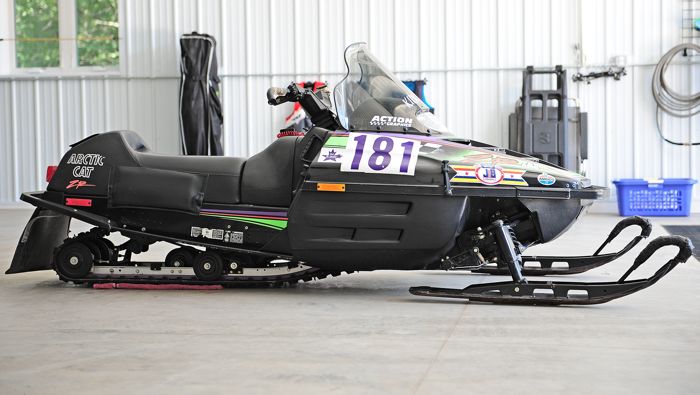The 1993 Arctic Cat ZR 440 (and 580) are among the all-time great snowmobile model introductions. The competitive achievements of this first-year model set the tone for one of most commercially successful machines in Arctic Cat history.
Aboard these purpose-built machines, Team Arctic racers rode roughshod over the competition in cross-country, snocross and oval events throughout the 1993 season, effectively erasing from memory the two lost years aboard the Prowler-based machines.
Kirk Hibbert’s victory in the St. Paul to Thunder Bay I-500 cross-country was perhaps the most significant win for a ZR that season.
This is that sled.
Thankfully Kirk kept this machine (as he also did with his 1990 EXT Special that he won Jeep 500 with), in original condition no less!
Other than an appearance at Arctic Cat’s 50th Anniversary, this machine has lived its post-race life in Kirk’s shop, among a handful of other significant machines associated with the Hibbert family.
The good news is that this historic Cat will be seen a little more frequently in the coming weeks and months. I shot these pix when the sled was parked in Tucker Hibbert’s shop last week, where it was being used in a cool video project that will soon splash the internets.
Other than a wipe down with a rag and polish, this sled is exactly as was when Kirk Hibbert crossed the finish line in Thunder Bay to win his second I-500, following an epic battle with Polaris racer Doug Lasher in the closing miles of the four-day event which saw the two finish within FOUR seconds of each other!
Like pretty much all of Kirk’s sleds, this one shows little by the way of battle scars. That’s because he almost never crashed or banged into people.
In fact, very little on this machine indicates it’s been ridden, let alone raced to victory in the biggest of all terrain events.
The hockey tape wrap on the grips shows the wear of racing (and time). And somewhere along the way, the curved portion of the Wilwood brake lever was broken off.
What struck me when looking over the sled was just how little had been done to race-prep it for the I-500. The curved ends on the handlebars were a couple of the personal touches that Kirk added.
Another was adding side pads on the seat.
Bolts that were cut-off and running through the running boards provided added foot traction.
Speaking of traction, Kirk ran 96 Woody’s Gold Diggers.
He added small plate bracing to the skis (on top, under the spindle plate and along the bottom channel).
Plastic foot-protectors/keepers were added to the stirrup area of both running boards, mainly to keep his foot in place (rather than protection).
Additional straps on the front, sides and back were added to keep the hood in place.
The spare throttle block is still taped to the rear console vent.
The odometer shows 845 miles.
The race itself accounted for 640 of those miles, as that year’s event was four day (rather than the typical three).
Day one started in Wyoming, Minn. and finished in Brainerd. The second day went from Brainerd to Duluth. The third leg was Duluth to Grand Marais, while the final day was Grand Marais to Thunder Bay, Ontario.
Under the hood, only surface rust on some of the components betrays the 21 years that have passed since this machine was crown the champ.
Like the rest of the machine, there was very little “special” building done to make this otherwise stock machine a race-winner. Hibbert made a career out of focusing his attention on shocks, suspension calibration and handling.
Coils were a potential weak point for these engines, so Kirk had a second one ready to go should he need it.
Then (and sometimes even today) racers were wise to add a third spring (and associated tabs) to the exhaust/muffler junction.
It’s hard to see, but washers were welded to the bulkhead where the A-arm attached.
Here’s a shot I grabbed on the final day of the race, when Kirk started in third place, three minutes and eight seconds behind Doug Lasher. Brad Pake (who was then on a Polaris) started the day in second, 53 seconds ahead of Hibbert.
Hibbert ran mistake-free and with blazing speed to catch and pass Lasher for the win. His winning time was 11:37:01.
I snapped the photo above just minutes after Kirk crossed the finish line.
Anyone recognize some of the people standing behind the banner in the background?
There were 218 people who started the race, and 114 who finished.
As usual, Polaris had a damn strong finish in the race. And as usual, they had the vast majority of entries, which was a major factor in the finish.
Arctic Cat’s amazing success here and at all the race events in 1993 would turn the tide and usher in a new era where Cat had as many (and often times more) entries as their competitor from up the road.
Kirk’s win in 1993 was a thrilling accomplishment for himself and Team Arctic. A new era had begun, and a couple legends were well on their way to fruition.
Thanks for reading.
